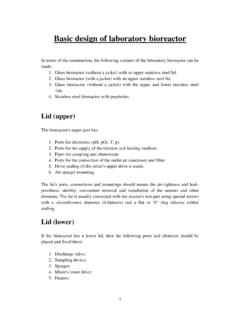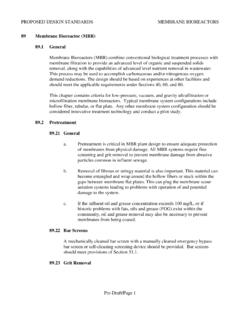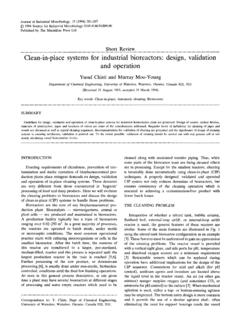Transcription of BIOREACTORS AND CULTIVATION SYSTEMS FOR …
1 BIOTECHNOLOGY Bioreactoes and CULTIVATION SYSTEMS for Cell and Tissue Culture - Popovic , Ralf Portner BIOREACTORS AND CULTIVATION SYSTEMS FOR CELL AND. TISSUE CULTURE. Popovi . Beuth Hochschule f r Technik,University of Applied Sciences, Berlin, Germany Ralf P rtner Hamburg University of Technology, Institute of Bioprocess and Biosystems Engineering, Germany Keywords: Mammalian cells, insect cells, plant cells, tissue engineering, stem cells, BIOREACTORS Contents S. TE S. 1. Introduction R. AP LS. 2. Mammalian cells Products from mammalian cells Properties and medium requirements of mammalian cells C EO. BIOREACTORS for mammalian cells Categorization Immobilization of cells Process strategies E . bioreactor design and scale-up H. BIOREACTORS for cell suspension PL O. Fixed bed and fluidized bed reactors Hollow fiber and membrane reactors M SC. Single-use BIOREACTORS 3.
2 Insect cell culture 4. Plant cell culture 5. Tissue engineering and stem cell culture SA NE. bioreactor concepts for tissue engineering Propagation of stem cells 6. Regulatory and safety issues U. 7. Conclusions 8. References Summary Cell and tissue culture is the complex process by which cells, mostly of mammalian or plant origin, are grown under controlled conditions. The importance of cell and tissue culture in large scale is reflected in the many valuable products for human health. Products from mammalian cells such as monoclonal antibodies, cytokines, recombinant glycoproteins, and, increasingly, vaccines dominate the biopharmaceutical industry. Regenerative medicine using human primary and stem cells opens new therapeutic concepts. Additionally, plant cell and tissue cultures for the production of biologically active substances (low molecular secondary metabolites and recombinant proteins) are of growing importance.
3 Numerous BIOREACTORS and CULTIVATION SYSTEMS for cell culture, Encyclopedia of Life Support SYSTEMS (EOLSS). BIOTECHNOLOGY Bioreactoes and CULTIVATION SYSTEMS for Cell and Tissue Culture - Popovic , Ralf Portner either for production of biopharmaceuticals or for tissue engineering, have been developed. Due to the special characteristics of these cells specific solutions are required. The following contribution gives an introduction to the characteristics of cell culture technology and introduces bioreactor SYSTEMS and CULTIVATION strategies applied. 1. Introduction Efficient CULTIVATION of mammalian, tissue or plant cells requires comprehensive knowledge of biological as well as biochemical fundamentals ( characteristics of cell growth and metabolism, cell line establishment, culture medium optimization) and related engineering principles ( bioreactor design, process scale-up and optimization).
4 This chapter gives an introduction to the special demands on design and operation of the before mentioned cells due to their specific characteristics. It shall help to understand S. TE S. the importance of cell culture technology as well as differences compared to microbial R. AP LS. fermentation technology. The first sections are related to mammalian cells. Due to the importance of these C EO. techniques they are explained more in detail. Further sections address special cell culture applications having a high potential for further development, including the insect cell-based recombinant protein production and the plant cell-based bioprocessing. Finally, CULTIVATION of primary tissue and stem cells is discussed. E . 2. Mammalian Cells H. PL O. Products from Mammalian Cells M SC. Mammalian cell culture or animal cell culture is devoted to the application of cells isolated originally from mammalian tissues and further cultivated and reproduced in an artificial medium under controlled conditions (in vitro) (Figure 1).
5 An overview on SA NE. applications is given in Figure 2. U. Figure 1. Examples for (a) cells for suspension growth (hybriodoma cells) and (b). adherent growing mammalian cells (HepG2 cells). Encyclopedia of Life Support SYSTEMS (EOLSS). BIOTECHNOLOGY Bioreactoes and CULTIVATION SYSTEMS for Cell and Tissue Culture - Popovic , Ralf Portner S. TE S. R. AP LS. C EO. E . H. Figure 2. Fields of application for mammalian cells (from Eibl et al. 2009, modified, PL O. with kind permission from Springer Science+Business Media). M SC. Mammalian cells synthesize a vast range of biopharmaceuticals ( products from cells . in Figure 2) that cannot be expressed by recombinant microbial techniques, including viral vaccines, antibodies for diagnostics, therapeutic proteins (rec. glycoproteins, SA NE. antibodies). Viral vaccines against polio, hepatitis B, measles, influenza or mumps for human use, rubella, rabies, or food-and-mouth-disease (FMD) for veterinary use, among others, are U.
6 Produced very efficiently by means of a cell-based vaccine technology. Genetically engineered or DNA-vaccines are under development. For vaccine production mainly primary cells, diploid cells or permanent cell lines are applied, recently even recombinant established cell lines (see Section ). Monoclonal antibodies are widely applied in diagnostics as well as in therapy. The antibody technology was first based on hybridoma cells. As these mostly mouse-derived antibodies cause severe immunogenic problems during application in humans, nowadays chimeric, humanized or human antibodies are produced by means of established cell lines (see Section ). In diagnostics, tens of thousands different monoclonal antibodies are available having a specific binding to target molecules. Antibodies are applied in therapy as well, organ transplantation, cancer diagnostic and treatment, rheumatoid arthritis, leukemia, asthma, or multiple sclerosis.
7 For some Encyclopedia of Life Support SYSTEMS (EOLSS). BIOTECHNOLOGY Bioreactoes and CULTIVATION SYSTEMS for Cell and Tissue Culture - Popovic , Ralf Portner antibodies the production scales have reached kilogram quantities. Recent developments are dealing with new antibody formats such as fragmented antibodies (FAb s) or bivalent antibodies. Production of recombinant glycoproteins as human therapeutic agents by mammalian cells, has been well established and in use since the 1990s. Here valuable products such as cytokines ( Interferons and Interleukins), hematopoietic growth factors ( Erythropoietin for treatment of anemia), growth hormones, thrombolytic agents ( tissue plasminogen activator [tPA]), coagulation factors (factor VII, factor VIII, factor IX etc.), and recombinant enzymes (DNAse) are just a few. Most of these proteins cannot be produced in bacterial or yeast cells, as only mammalian cells are able to provide the required specific, human-like glycosylation pattern, which is difficult to obtain in other host SYSTEMS .
8 During the 2000s the main drawbacks of mammalian cell culture, high shear sensitivity, cell adherence requiring a surface for cell growth and low product yield have been overcome at least for most cell lines used in large scale S. TE S. production. Alternative expression SYSTEMS such as transgenic animals are still under R. AP LS. development and do not compete against 'classical' mammalian cell culture at present. Regenerative medicine or tissue engineering is devoted to cell therapy (bone marrow C EO. cells, stem cells etc.), functional tissue for transplantation or extracorporal organoids ( artificial liver and kidney) ( Cells as Products in Figure 2). Here the challenge is to develop artificial organs in bioreactor SYSTEMS (tissue engineering of liver, kidney). and tissues (skin, cartilage, bone), or the expansion of hematopoietic cells for bone marrow transplantation or gene therapy.
9 E . H. In drug development and drug testing new challenges arise from new regulatory PL O. requirements, mainly as animal trials have to be replaced by cell culture assays, preferably by test SYSTEMS with human material ( Cells for substance testing in Figure M SC. 2). Therefore cell cultures are applied for substance testing, In vitro testing to replace animal trials, drug testing, substance validation (toxicity, chemicals, REACH. program). As 2 D monolayer cultures are often unsatisfactory, tissue-like 3 D cultures SA NE. are investigated as an alternative. The exciting prospects of these new techniques are outlined in Section 5. U. Properties and Medium Requirements of Mammalian Cells Mammalian cells relevant for industrial processes can be characterized as follows: Primary cells cells taken from the tissue and further grown in vitro, without doubling.
10 Cell strains - When these cells start to divide, you will get a cell strain, with finite life time (30-40 generations) and the cells are unchanged. Permanent or established cell lines cells that have gone through some transformations (in-finite life-span, used for expression of recombinant proteins). Hybridoma cells cells obtained through the fusion of Lymphocytes and tumor cells, expression of monoclonal antibodies. Encyclopedia of Life Support SYSTEMS (EOLSS). BIOTECHNOLOGY Bioreactoes and CULTIVATION SYSTEMS for Cell and Tissue Culture - Popovic , Ralf Portner During CULTIVATION of mammalian cells in vitro, outside of a living organism, some distinct difficulties arise from the extraction of the cells from a safe tissue. Slow growth rates with doubling times between 18 and 28 hours, low productivity, a high sensitivity against shear stress due to the lack of a cell wall and high demands in respect to the growth medium, all challenges for the techniques required for mammalian cells.














